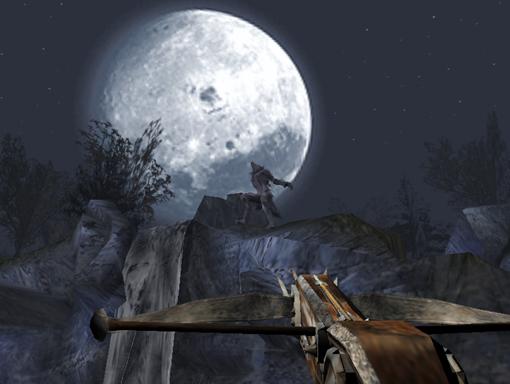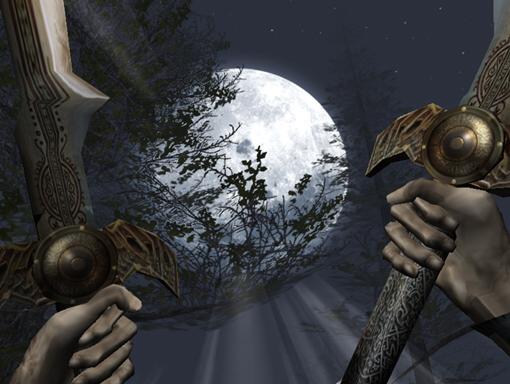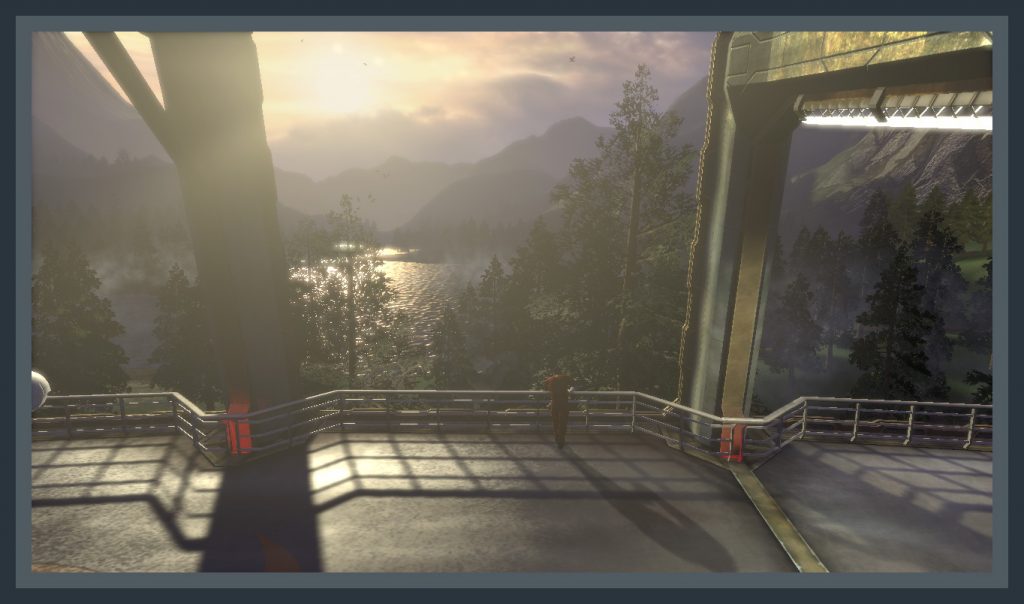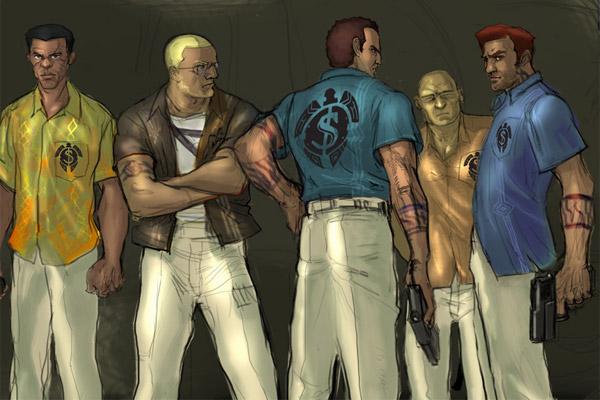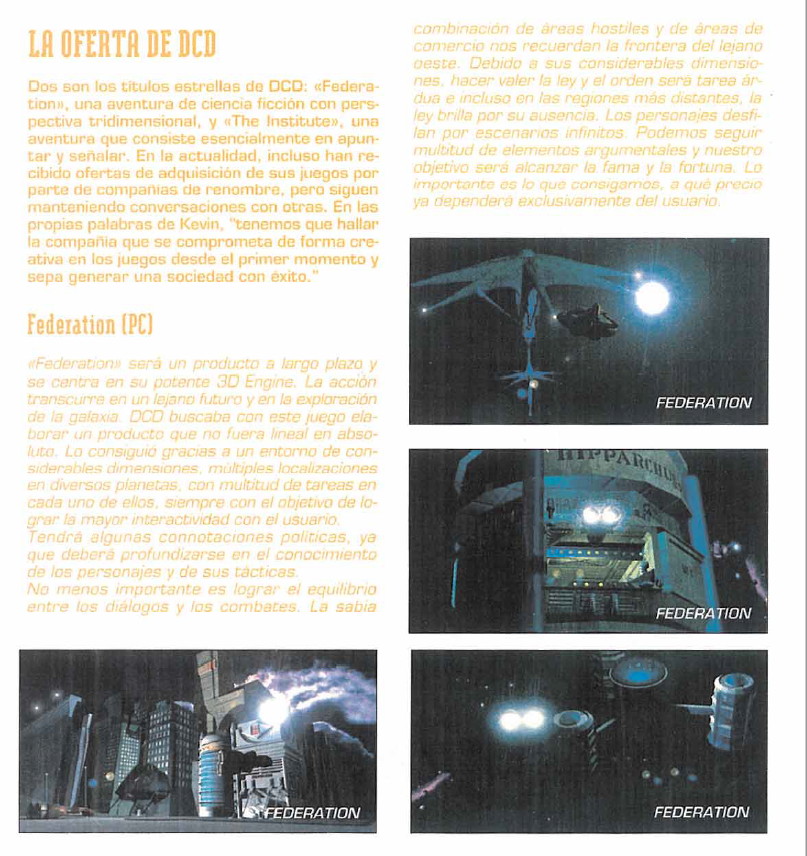Legend of the Blade Masters, also stylized Legend of the Blademasters and Legend of the BladeMasters, is a cancelled fantasy role-playing game developed by Ronin Entertainment and published by Ripcord Games, from 1997 to 2001, for the PC and the Dreamcast. In Legend of the BladeMasters, player took the control of a 17 years old boy named Erik Valdemar who, one day, stumbled across a cursed sword in the forest. It turns out that this sword is one of seven magic blades that are being sought out by five ruthless guardians. Erik must master the magic of the blades as he learns of their connection to the devastation of the kingdom. In his quest, he will be joined by four other characters: O’Lora Kita, a young elf who wants to bring peace to her city, August Winslow, an Elemental wizard and guardian spirit of Windor, who can talk to animals, Lucan, a mountain Orc raised to be chivalrous, serving as the squire of Knight Rudenstein and vowing to become more like his master, and, finally, the mysterious Knight Macon.
More information was shared in April 1999 with an interview of the core team by GA Source:
Very little information is known about Blade Masters, could you tell us something about the plot?
Leonard Robel: It all starts with a bold king who, by the aid of a young wizard, befriends the five dragons of the land. Unfortunately jealousy over a woman arises, and the wizard ends up hiding for his life in a deep, dark cave. His anger and loneliness slowly drives him insane, and his plots against the king begin to tear the kingdom apart. Then some things happen that even the wizard doesn’t understand. The hero is just a boy, named Erik Valdemar, who comes across a strange powerful blade in the forest, and finds he is now part of something much more incredible than he could have guessed.
How and when did the idea for Blade Masters first come up? How long have you been working on it? What would you rate as the major influences on the game in terms of both game and non-game influences?
Harrison Fong: My major influences for designing BladeMasters came from playing a lot of the good old fast action arcade games of Gauntlet and Dungeon & Dragons. In addition, I am a fan of the amazing Jet Li in his Chinese movies, such as Once Upon Time in China, and admire the astonishing visuals and story of director Hayao Miyazaki’s Nausicaa and Laputa. BladeMasters combines several of these influences into an interactive game.
What sort of unique features and capabilities will your proprietary engine have?
Juan Carlos Arévalo Baeza: In terms of gameplay, there are a few: first and foremost, the AI system, which is built using multi-threaded, layered state machines. This allows us to create behaviors that are as good as, if not better than, any we’ve seen before. And also, there’s the customizability. We already explored that concept in Armor Command, and expect to bring it to its fullest in BladeMasters.
Will you have any other new NPC’s to assist you in your missions?
Harrison: At the beginning of the game you only control Erik Valdemar. But as you journey the worlds, you’ll meet additional heroes who will join the party. You might be in the midst of saving them or sometimes they are saving you. You’ll be able to control up to three characters out of five. Each character will be different in their attitude and choice of weapons.
Tell us about some of the weapons we will be using
Leonard: Each player character has his own favorite weapon he sticks to until he upgrades to one of the legendary blades. They use short-swords, two-handed mallets, great-swords, spears and double maces. They can also choose a ranged weapon, such as a bow, crossbow, knives, darts, caltrops, ancient bombs and guns, and that sort of thing.
In November 1999, IGN explained a little bit more the gameplay:
The game’s battle system will also stray a bit from the norm associated with most other RPGs of this form. Like Infograme‘s upcoming Silver, battles will be fully realtime, with you taking control of the entire party. The main character will be the only guy receiving your full control, though, with the other members of your party being controlled through commands. We’ve actually heard that the PC version will be featuring a multiplayer mode allowing up to four players to adventure simultaneously together.
In January 2000, Computer Games Magazine wrote a preview, featuring explanations provided by Game Designer Troy Dunniway:
Blademasters takes place over the course of about sixty levels, each a hand-built 3D area. Erik will be present through them all, but he will rarely be alone. This is a party game in which the player controls up to five characters at a time from a pool of a couple dozen NPCs that move in and out of the story, revealing plot elements as they come and go.
There are four main areas the player will visit. Alvante is the temperate forested area where the game begins. Kelta is a swampy jungle, Windor is a snowy mountainous area, and Vameria is a huge underground city. The story progresses linearly in one direction rather than moving outward in spurts from a central place. (…) There will be plenty of branching paths, mainly in the form of optional quests where you can help people in some fairly standard tasks: finding items or killing monsters threatening a town, for instance. “But we’ll also include some fairly elaborate quests that involve you figuring out who murdered someone or who is stealing things from someone else,” Dunniway says, “This will involve a bit of detective work. For some quests, you’ll have to use your brain, for some your sword.”
In one subplot, you’ll have to find a set of gears to repair the machinery in a millhouse that extends a bridge to a hidden area with bonus items. For one quest, you can release fish into a stream by breaking a dam down. This will distract a flock of ravenous birds nearby that were preventing you from reaching another area. Dunniway says that most of these quests are optional rather than obstacles in the way of the storyline. Most of them will simply yield new goodies to help you along the main plotline. (…)
(…) There are ten areas of magic (the four elements, of course, plus Lightning, Dark, Holiness, Mind, Plant, and Time) and each character can master five of these areas. Each area has two spells: a weak force and a strong force. “Most of these different forces are completely different spells,” says Dunniway, “not just stronger versions of the same spell. Some of the strong force spells might also do, say, an area of effect damage or attack multiple targets, where the weak force only attacks a single target.” (…)
(…) Most of the spells Ronin is showing off seem combat oriented, but they feature some pretty fancy animation. Summoning a rock man causes boulders to stack up into an animated character who fights for you before crumbling back into his component boulders. Enormous hands reached out of the earth for one spell, smashing the hapless victim between their palms in a huge giddy clap. When meteorites fell from the sky, the entire screen shakes with the force of their impact. And when the power of one of the blades is unleashed and a dragon guardian enters the fray, he rivals anything you’d summon in the Final Fantasy games.
Characters start off with some spells, but the rest will have to be “learned” in the form of spell gems. “The idea is that magic within the world will gather in certain spots,” explains Dunniway, “and when too much gathers, it coalesces into a small hard gem. Anyone who has the ability to cast magic, and has the ability to master that kind of magic, can pick up one of these gems and infuse the spell into themselves.” Dunniway explains that the gems aren’t sold like other items in the game, so you’ll have to find them in the game world rather than buying them or earning them through experience.
(…) Each character has a unique melee weapon, which can be enhanced in one of five magic areas (Water, Wind, Earth, Fire, and Lighting). These enhancements can also be cast on the secondary weapons that any character can use. Secondary weapons will generally be ranged weapons like bows, crossbows, molotov cocktails, and even flintlock pistols. Dunniway explains that Blademasters will introduce a queuing system to help you control the way secondary weapons are used. “They have a five slot queue. Your character uses whatever is in slot one and whenever that is used up, he cycles to slot two and so forth. A blank slot will pause the queue. You can put, say, ten arrows in slot one, two molotov cocktails in slot two, five bullets in slot three, nothing in slot four, and then 50 arrows in slot five. The character would then shoot the first ten arrows, then throw two cocktail, shoot five bullets and stop so the player could restart the queue if he wanted. It’s a very flexible and powerful system.”
Dunniway mentions another hugely successful game when he talks about Blademasters’ multiplayer support. “It will be similar to Gauntlet, where all the players are working cooperatively to get through the level and on the next.” You’ll start in a castle where you configure your character based on the powerups you grab. Then you pass through teleporters to clear out succeeding levels and solve puzzles, returning to the castle to restock as needed. “It’s designed to be playable in a very short period of time, from thirty minutes to several hours. We wanted a more casual multiplayer experience that you won’t have to play for days on end.” (…)
For its part, Gamespot told us:
The world of Legend of the Blade Masters was once populated by an assortment of dragons. However, these dragons were constantly fighting amongst each other to become the sole possessors of the five elements – earth, wind, water, wood, and fire. A great war ensued, and after the dust settled, only five dragons remained. Incredibly tired from battle, the dragons decided to rest in five different caves scattered across the land. While the dragons slept for thousands of years, humans became the dominant force in the world, thanks to the peaceful, unifying efforts of a single king. However, the peace was shattered when a series of dark holes began to appear across the land.
Out of these holes climbed the most evil creatures to ever walk the land. Humans watched helplessly as the creatures destroyed all that the humans had built. The king, who knew of the five legendary dragons, searched the land for a wizard capable of summoning the dragons to destroy the creatures that sprang from the dark wells. After a lenghty search, the king finally discovered the only wizard who was capable of waking the sleeping dragons. Together, the king and the wizard, Aberhart, began the journey to find their winged saviors. Eventually, the king and the wizard came back from their quest with the five dragons, and together, they were able to push the dark creatures back into their wells.
However, after the victory against the dark creatures, the king and wizard became bitter enemies. The wizard had an affair with the king’s wife, and the jealous king ordered his wife and the wizard executed. The wizard managed to escape death, but the king’s wife was killed by an arrow through the heart.
Vowing vengeance, the wizard dedicated himself to black magic and summoned a demon ally to help him destroy the kingdom and imprison the king’s five dragons in five swords. The demon, however, betrayed the wizard and scattered the five swords across the land. As soon as the king learned of the dragons’ imprisonment, he summoned the last of his remaining knights to help him find the swords before the vengeful wizard could.
Legend of the Blade Masters starts immediately after the events illustrated above. As the intro movie comes to a close, you’re character, Erik Valdemar, joins the search for the five swords.
From a gameplay standpoint, Legend of the Blade Masters hopes to compound the standard adventure formula by adding RPG and strategy elements to its character and combat systems. The game’s 3D world is presented from an overhead perspective a la Zelda, and exploration takes place in a continuous world. When you control Erik and up to two of the four companions that will join him, the camera focuses on the character in the lead, with the other two characters following intelligently. Combat extends this AI system substantially. While you control the main hero directly, you can issue general commands to teammates, and the game will then do its best to have the characters carry out these orders. Enemy behavior changes under varying conditions, so adapting the party to each battle will be a strategic challenge.
In the same period, it was revealed that the second game, online only, named Quest of the Blade Masters was merged into Legend of the Blade Masters:
In addition to the 41 substages, Legend of the Blade Masters will contain an extensive multiplayer mode. Ripcord originally planned to release the single-player and multiplayer versions of Legend of the Blade Masters as two separate games with the multiplayer game titled Quest of the Blade Masters. The plan to merge both games was officially announced a few weeks ago, which should give you an indication of the depth of Legend of the Blade Masters’ multiplayer mode. Instead of just offering a multiplayer version of the single-player game, Blade Masters’ multiplayer mode significantly changes the pace of the game with gameplay weighted toward action rather than role-playing. The landscape is filled with many more enemies than in single-player, and your main objective will be to kill just about everything in sight.
There is a surprisingly high level of customization in the multiplayer mode as well. After selecting your character, you can decide whether you want to cooperate with other characters or compete against them, and then you can adjust details for each level such as the amount of items, enemies, and gold, as well as the character levels. You can even select the level in which you will be competing against or working with four other players.
According to Ripcord, this latest version will prominently feature the actual quest, with up to 8 players simultaneously online (…) Other online modes include multiplayer challenges like king of the hill, hidden key (like capture the flag), and last man standing.
During its whole period of coverage, Legend of the Blade Masters was constantly pushed back in terms of its release date: from August/September 1999 to the first quarter of 2000, then to November 2000 and finally to 2001.
Unfortunately, in March 2001, following the drastic restructuring of SEGA after the financial failure of the Dreamcast, Ripcord Games announced that some of their games were cancelled. Legend of the Blade Masters was one of them:
(…) Lately, it’s been more of the ugly news of third parties canceling their Dreamcast games and now, Ripcord Games might join that list soon.
“We have put a hold on the further development of our Dreamcast games,” stated John Peterson, Executive Vice President of Ripcord Games. “While we believe the Dreamcast is a great system, SEGA’s new business direction [into the software business] has made us re-evaluate our current state.” Mr. Peterson wouldn’t go so far as to state the Ripcord Games for the Dreamcast – Legend of the Blade Masters, GorkaMorka, and Shrapnel: Urban Warfare 2025 – were cancelled, but are pending publisher’s decision.
Ripcord Games definitely closed offices in April 2001, ruining the chances of Legend of the Blade Masters, Shrapnel: Urban Warfare 2025 and Gorkamorka being released, at least, on PC.
Images:
Videos:

